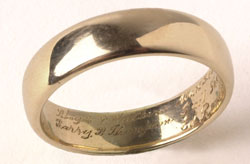Our Traditions
Many men and women have come before you, each leaving their lasting legacy within the walls of this grand institution. Passed down, from generation to generation, are the values and beliefs the founders of West Texas A&M University established. We show this pride through our actions and our words; a lasting reminder of those who came before.
| Academic Banner | Academic Mace |
| Academic Regalia | Alma Mater |
| Buffalo | Buffalo Stampede |
| Eternal Flame | Fight Song |
| Gonfalons, Historic Banners | Hand Sign |
| Presidential Ring | Standing Tall |
Academic Banner

The banner is developed from a type of Roman cavalry flag, which was a rectangular piece of cloth attached to a crossbar fastened to the head of a spear. This type of standard was eventually adopted by the Roman emperors and held a large flag of silk embroidered in gold.
The banner in medieval times was a heraldic flag that indicated the presence of a monarch, prominent person or commander. Over the years it has been adapted to represent a variety of institutions and normally bears the symbol of the institution.
The academic banner is carried by a senior member of the faculty.
Academic Mace

The mace is derived from a weapon used in medieval times. It was a heavy club with a spiked metal ball at the end used to smash an opponent’s armor. It was often borne by a bodyguard to protect a king or person of high status in processions. Through the years, the mace has changed from a weapon into a purely ceremonial symbol of office.
Maces are currently used in the United States House of Representatives and in many academic and ecclesiastical processions.
The academic mace is carried by a senior member of the faculty.
Academic Regalia
The baccalaureate gown is black with pleated front panels. The master’s gown is black with very long sleeves and includes a distinctive hood. The doctoral gown may vary in color and is distinguished by velvet panels around the neck and down the front of the gown. Three horizontal velvet bands in black or the color representing the appropriate degree mark the doctorate. In America, the doctoral hood is the most colorful feature of academic regalia.
Master’s candidates wear a black hood bordered with a band of velvet in the color representing the degree received, while the hood is lined with the colors of the granting institution.
At WTAMU, the lining is maroon and white, and colors representing the degree earned are:
- Agriculture - maize
- Arts - white
- Business Administration and Professional Accounting - tan
- Business Education and Education - blue
- Fine Arts - brown
- Music - pink
- Science - gold
- Nursing - apricot
Alma Mater

The University's Alma Mater was written in 1921 by S. Elizabeth Davis, assistant professor of English. During the years that chapel attendance was required, the singing of the Alma Mater was a ritual that brought the morning's program to a close. " Sing with enthusiasm as well as with reverence and feeling," Wallace R. Clark, head of the music department, would say. He was equally adamant about singing the Alma Mater only on appropriate occasions. "It is a hymn," he declared firmly, "and should be sung with a reverent attitude when and where a spirit of reverence is fitting." Students learned Clark's lessons well, and even after more than 80 years, the Alma Mater is sung in reverence by current and former students, standing tall and with "horns" held high.
Over boundless reach of prairie,
Over rolling plains,
Over cliff and crag and canyon,
Alma Mater reigns!
To maroon and white, our colors,
We would faithful be --
Hearts as bold as western breezes,
Souls as pure and free!
Round thy image, Alma Mater,
Hallowed memories twine;
Bless the sacred ties of friendship
Pledged before thy shrine.
Alma Mater! Alma Mater!
We will faithful be;
Through the years that lie before us
We'll remember thee!
Buffalo
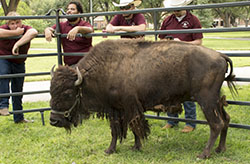
The mighty buffalo has stood the test of time and tradition at West Texas A&M University, gallantly capturing the spotlight at athletic events, parades and public appearances too numerous to count.
However, had it not been for T-Anchor cowboy L. "Parson" Gough, West Texas A&M’s mascot might be a badger, a chaparral, a coyote, a rattlesnake or a prairie dog. All of these common campus pests, at least in 1921, were nominated as the school’s mascot by the student body, and it was a heated debate until Gough took the floor. He got up and described an adventure he had in 1892, when he and another cowboy had roped two buffalo calves on the very site where Old Main was built. The student body stood in unison to cheer for Gough’s nominee, and the buffalo has served as a majestic symbol of the University ever since.
The first University buffaloes were purchased in 1922 from the historic herd maintained by Charles and Mary Ann Goodnight on their T-Anchor Ranch. The young buffaloes were aptly named Charlie and Mary Ann, and it was Charlie who performed the functions of the mascot, running the sidelines at football games and parading the Homecoming streets. Charlie, after 13 years as the University’s first mascot, died in 1935 and was mounted for posterity. The huge, lifeless figure failed to motivate the football team as he once had and was finally retired to the Panhandle-Plains Historical Museum.
Mary Ann and a few offspring were sent to pasture, and the University went without a full-time live mascot until 1977. That’s when Thunder (called Lollipop) was obtained, beginning the line of Thunders that continues today. Thunder II (Buford), Thunder III (Max), Thunder IV (B.J., the offspring of Buford and Lollipop) and Thunder V (Ladee, pronounced LAY dee) took their turns over the years, finally giving way to Thunder VI (Sadee, pronounced SAY dee) in 1996.
Sadee’s retirement in 2004 paved the way for the University to return to its mascot roots as Thunder VII is the first buffalo to come from the original Goodnight herd—one of the last pure buffalo herds in North America—since Charlie and Mary Ann.
Christened Charlie Jr. and known as "C.J.," the bull calf was obtained in December 2004 from the Texas Parks and Wildlife Department, which maintains the Goodnight herd at Caprock Canyons State Park in Quitaque. Unfortunately, C.J. was found dead in his pen on Monday, May 30, 2005. An autopsy revealed that his death was caused by a small piece of metal wire that he ingested.
The University immediately began a search for a new live mascot and found two—Thunder VIII (Jack) and Thunder IX (Liz), half-siblings who were donated by and named after Jack and Liz Longbotham of Abilene. Both buffaloes performed mascot duties until 2008.
The Herdsmen joined the National Bison Association (NBA) in February of 2008 and began to look for a new buffalo to replace Thunder IX, who was becoming more aggressive. While reading an online NBA newsletter, they came across a story about a buffalo calf that was being bottle fed after its mother died. A buffalo accustomed to human contact was the perfect opportunity and after a 40-hour round trip to Indiana, Thunder X was in his new Canyon home. He made his official mascot debut on Nov. 8, 2008, at Kimbrough Stadium. Thunder X was retired in 2011 when the reins were passed to Thunder XI.
Thunder XI (Lillie) was acquired from the Jay Barksdale Bison Ranch in Crockett, Texas due to the Herdsmen membership in the Texas Bison Association. Thunder XI was an orphaned calf and was bottle fed by the Herdsmen. Thunder XI served the university well until 2015 when she was retired.
In the fall of 2014, the Herdsmen received a call offering the loan of a bull buffalo calf for the program from Kay Jameson in Shamrock, Texas. The Herdsmen went to Shamrock and brought Thunder XII home to enter the training program. In the fall of 2015, Thunder XI was officially retired and Thunder XII took over official mascot duties.
Thunder XIV arrived in 2021 and, beginning in 2023, resumed the practice of running onto the First United Bank Field at Bain-Schaeffer Buffalo Stadium at the start of each game. Thunder XV was adopted in 2024 and, as of Fall 2024, is being trained to take over as the official mascot within 12 to 18 months.
The buffalo has been a steadfast pillar of strength, honor and majesty, and the words that appeared in a 1921 issue of the University’s student newspaper, The Prairie, still hold true today—"Now, since the Buffalo is to be our mascot, what qualities are we to think of when we see him gracing all our insignia? First of all, he is strong and sturdy.
And his virtues are as prominent as his physical qualities. He always fights a clean fight, and he was never known to sneak away from his foe on the field of battle or to betray his friend. His broad shoulders tell you that he can endure physically, and his sincere eyes bespeak the soul which supports his physical power."The Charles K. and Barbara Kerr Vaughan Pedestrian Mall features a marble sculpture of a buffalo and calf by artist Doug Scott of New Mexico. The "Original Texans" sculpture sits prominently along Buffalo Walk north of Old Main and is encased in a cascading water feature. Check out a video about the making of the sculpture from artist Doug Scott.
Buffalo Stampede
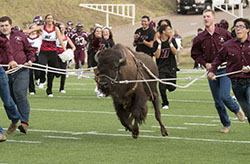
Everybody loves a touchdown, but it's the traditional buffalo run across the field that really gets everyone excited, especially when the University mascot hits stride and the Herdsmen handlers lose their footing. It's all part of the game.
Eternal Flame
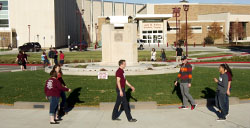
The Eternal Flame, now located in Victory Circle, was originally constructed in 1966 at the west entrance of campus by the WTAMU Alumni Association. Representing the burning desire and quest for knowledge, the flame is a common symbol for the University. Fire brings light and warmth, but it can also bring destruction as it did in 1914, when fire destroyed the only building on campus. While the physical structure of the University was completely destroyed the spirit remained, and in 1916, the building we know as Old Main rose from the ashes. Many analogies have been drawn between that reconstruction and the fabled mythological bird, the Egyptian Phoenix. The comparison draws on the building rising again from its own ashes just as does the Phoenix and is symbolic of the undying spirit of this University, a spirit which will always live within its students and alumni. In 2014, the eternal flame was relocated a couple hundred yards east to victory circle.
Fight Song
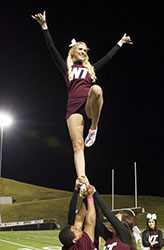
The University's Fight Song was written by Jack Curtice, a member of the football coaching staff from 1938 - 1941. Other fight songs have been introduced, one as recently as 1963, but none have been able to undermine the popularity of Curtice's "On, On Buffaloes."
On, on Buffaloes,
We are right for the fight tonight;
Hold that ball and hit that line,
Every buffalo will shine;
And then we'll fight for maroon and white,
And we'll roar for the old varsity;
We'll kick, pass and run
Till those ________ are done;
And we'll bring home the victory!
W - T - A - M, WTAM, Fight! Fight! Fight!
Gonfalons, Historic Banners
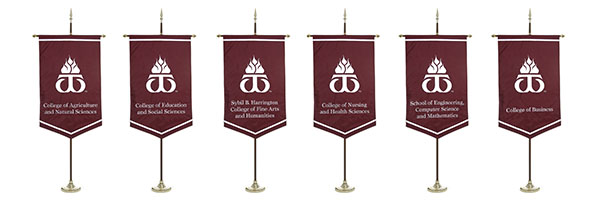
The gonfalon, a flag that hangs from a crosspiece or frame, originated in the medieval republics of Italy as an ensign of state or office.
Gonfalons have been adopted in many universities around the world as college or institutional insignias.
The University’s gonfalons represent the five colleges that make up West Texas A&M University and are carried in procession at commencement ceremonies to designate the colleges of the graduating students. The gonfalon for each college features a different color and distinctive image representing that college.
Hand Sign
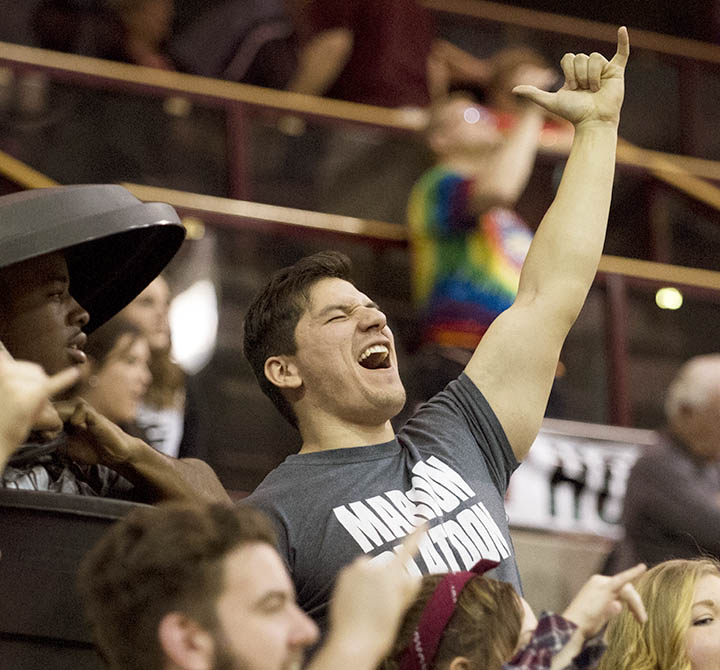
Fold your middle three fingers to your palm, extend your thumb and little finger and you've got your own set of buffalo horns. The sign, with hand held high, is proudly displayed during the alma mater, when a player is injured and as an energetic addition to cheers and the fight song.
Presidential Ring
R. B. Cousins, West Texas A&M University's first president, placed a solid-gold ring, a symbol of the "purity and the permanency of the invisible values" that the University seeks to develop, on the finger of his successor, J.A. Hill. Three decades later, in 1948, Hill passed the ring to President-Elect James P. Cornette with these words:
These 30 years, I have not forgotten this beautiful and meaningful symbolism and, tonight, with deep emotion and with profound conviction as to the high mission of our college, I pass to you this endless band of gold. I charge you to wear it throughout your administration of this beloved institution, keeping its symbolism warm in your heart and following the inspiration of its solid and endless meaning in the discharge of your every duty. I place, sir, in your custody, the body and soul of a great institution.
Cousins (1910-1918), Hill (1918-1948) and Cornette (1948-1972) began a tradition that has continued into the modern day and now includes Lloyd I. Watkins (1972-1977), Max Sherman (1977-1982), Gail Shannon (1982-1984), Ed D. Roach (1984-1990), Barry B. Thompson (1991-1994) Russell C. Long (1995-2005) and J. Patrick O'Brien (2006-2016.)
Although the president no longer wears the ring presented to President Hill by President Cousins, he does wear the University's official Series Ring. The Series Ring is dated with the year the president took office, and the series number corresponds with the succession number of the current administration. Dr. O'Brien, the University's 10th president, wears a ring dated 2006 with the series number 10. The original presidential ring is presented to each president during the investiture ceremony and is then preserved for safe keeping.
Standing Tall
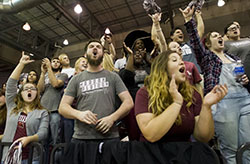
"Ehhhhhhvry-buddy uppppp" is a familiar cry at The Box before every WTAMU volleyball game and at the First United Bank Center before basketball games. Fans stand and clap in rhythm for the Buffs and Lady Buffs until the opponents score. Sounds like no big deal until you experience a lengthy dose of Buffalo domination.

